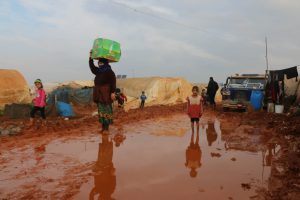The first round of food aid by the United Nations World Food Programme (WFP to people in Afar and Amhara who have been affected by conflict is now complete. However, due to various hindrances to the movement of humanitarian assistance, there has been a lack of supplies which has lagged behind the distributions in Tigray. Since 15th August, World Food Programme (WFP) has delivered food to nearly 300,000 people in Afar and Amhara. In Tigray, the second round of food distributions has been underway since 27th May and food assistance has reached more than 2.4 million people in the northwest and parts of southern Tigray.
Michael Dunford, WFP’s Regional Director for Eastern Africa, says that informal reports from all three regions of Tigray, Amhara, and Afar show that food insecurity is on the rise as families flee from their homes and their livelihoods are destroyed. In Tigray, the Integrated Food Security Phase Classification (IPC) released in June showed that by now, approximately up to 400,000 people would face famine-like conditions. As aid teams struggle to deliver adequate food assistance into the region, the situation is only growing worse. In Afar and Amhara, hundreds of thousands of people have been displaced from their homes and their livelihoods have been destroyed. To reach all the affected populations with emergency food aid before all of northern Ethiopia becomes a humanitarian catastrophe, it is crucial to have the full support and cooperation of all parties to the conflict.
WFP operations in northern Ethiopia:
According to the government estimates, Amhara and Afar regions have seen an additional 1.7 million people face emergency levels of hunger, with more than 840,000 people (140,000 in Afar and 700,000 in Amhara) having been displaced following the current conflict.
- The first round of food distributions in Amhara has been completed, having reached over 210,000 people with cereals, pulses, and vegetable oil. This includes the families displaced due to the conflict and those whose homes and livelihoods have been destroyed.
- WFP has also on behalf of partners transported over 2,200 metric tons of food assistance to North Wollo and Wag Hamra zones of Amhara. Deliveries to the communities beyond the conflict lines have however been impossible so far, hence threatening to exacerbate food security for families in those areas.
- In Afar, round one food distributions are almost complete, reaching an initial 80,000 people affected by the conflict, with a prospective increase to over 500,000 people in the next round.
- As of 24th September, emergency food aid by World Food Programme had reached over 2.4 million people across North-western, Eastern, and Southern zones of Tigray. In the third round of food distributions, WFP will reach around 2.7 million people after taking over Shire town and Tahtay Koraro districts in the North-western Zone from its non-governmental food partners.
In September, WFP had so far reached nearly 200,000 children under the age of five and pregnant and breastfeeding women with nutrition assistance in 39 out of the 71 targeted woredas in Tigray. In Shire town in the Tigray region, aid teams have only managed to provide each person with 2kg of pulses for the food distribution following the unavailability of oil and cereals. In addition to that, round 3 food distributions, which had been set to begin in early July, have not yet commenced due to Tigray’s lack of food. However, there have been some positive reports in recent weeks on the movement of humanitarian aid into Tigray. Five convoys (171 trucks) got into Tigray between 5th -29th September, with a combined total of 6,150 metric tons of nutrition and food supplies, which are adequate to feed over 360,000 people for a month. But despite these recent convoys, only 11% of the required humanitarian aid has got into the region.
Moreover, as of 30th September, over 90 commercial trucks left from Tigray and are now available to move humanitarian assistance into the region. Fuel which is vital for the running of the operations and the movement of humanitarian assistance into and across the region of Tigray is also running critically low. To keep operations running, 200,000L of fuel is needed to enter Tigray every week. WFP aims to reach 11.9 million people across Ethiopia in 2021 with nutrition, food, and cash support and activities to boost the food security and self-reliance of communities. For all activities under its Country Strategic Plan, WFP has a funding shortfall of US$426 million. To continue to scale up its response in northern Ethiopia to save the lives and livelihoods of people to the end of the year, World Food Programme (WFP) needs US$184 million so as to keep changing lives in Ethiopia.







